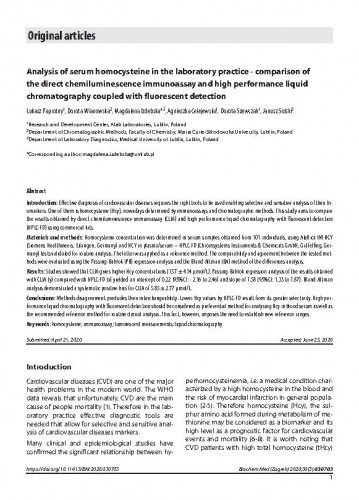Introduction: Effective diagnosis of cardiovascular diseases requires the right tools to be used enabling selective and sensitive analysis of their biomarkers.One of them is homocysteine (Hcy), nowadays determined by immunoassays and chromatographic methods. This study aims to comparethe results obtained by direct chemiluminescence immunoassay (CLIA) and high performance liquid chromatography with fluorescent detection(HPLC-FD) using commercial kits.Materials and methods: Homocysteine concentration was determined in serum samples obtained from 101 individuals, using Atellica IM HCY(Siemens Healthineers, Erlangen, Germany) and HCY in plasma/serum – HPLC-FD (Chromsystems Instruments & Chemicals GmbH, Gräfelfing, Germany)tests validated for routine analysis. The latter was applied as a reference method. The comparability and agreement between the tested methodswere evaluated using the Passing-Bablok (PB) regression analysis and the Bland-Altman (BA) method of the differences analysis.Results: Studies showed that CLIA gives higher Hcy concentrations (15.7 ± 4.14 μmol/L). Passing-Bablok regression analysis of the results obtainedwith CLIA (y) compared with HPLC-FD (x) yielded an intercept of 0.22 (95%CI: - 2.16 to 2.46) and slope of 1.58 (95%CI: 1.33 to 1.87). Bland-Altmananalysis demonstrated a systematic positive bias for CLIA of 5.85 ± 2.77 μmol/L.Conclusions: Methods disagreement precludes their interchangeability. Lower Hcy values by HPLC-FD result from its greater selectivity. High performanceliquid chromatography with fluorescent detection should be considered as preferential method for analysing Hcy in blood serum as well asthe recommended reference method for routine clinical analysis. This fact, however, imposes the need to establish new reference ranges.
Analysis of serum homocysteine in the laboratory practice - comparison of the direct chemiluminescence immunoassay and high performance liquid chromatography coupled with fluorescent detection / Łukasz Paprotny, Dorota Wianowska, Magdalena Izdebska, Agnieszka Celejewska, Dorota Szewczak, Janusz Solski.
Sažetak

 Biochemia medica : the journal of Croatian Society for Medical Biochemistry and Laboratory Medicine : 30,3(2020) / glavna i odgovorna urednica Daria Pašalić.
Biochemia medica : the journal of Croatian Society for Medical Biochemistry and Laboratory Medicine : 30,3(2020) / glavna i odgovorna urednica Daria Pašalić.